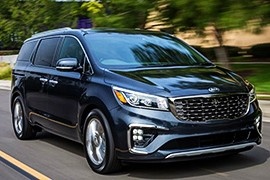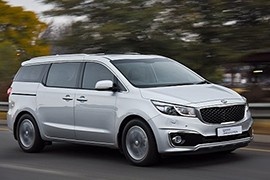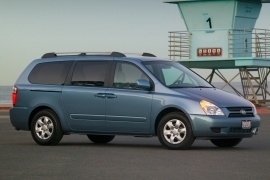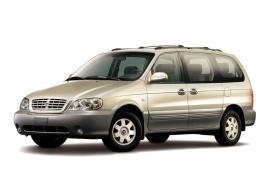
KIA Carnival / Sedona
Generations Timeline, Specs and Pictures

The 2021 Kia Carnival on U.S. soil was the moment when the Korean carmaker placed its new logo onto a vehicle, and that was a large MPV.
Minivans were not that much popular as they were in the late ’90s, and the SUVs were the keys to success. Kia took a different approach and designed an MPV like an SUV or the other way around. The Carnival/Sedona was introduced in late 2020 for other markets with the older, oval logo, while for the U.S. premiere, it brought it with the new one with stylized lettering that could be read as KIA or, with Russian letters, as KI.
The 2021 Carnival/Sedona looked like an SUV with rear sliding doors and a lower ground clearance. Its distinct, two-box bodywork featured a hood almost parallel to the ground, like most big-sized SUVs such as the 2017 Ford Expedition or the 2020 Chevrolet Tahoe. Its very long rear sliding doors and the raked forward C-pillar were a new design pattern for the Korean MPV.
Inside, Kia arranged up to three rows of seats for eight occupants. The middle seats from the second row could slide and be tilted for more comfort, while the middle seat could have been completely removed for easier access to the third row. Kia installed a pair of wide seats and a premium-looking dashboard with wood, leather, and metallic trims at the front. Depending on the trim level, the Carnival/Sedona featured analog dials for the instrument panel or a TFT display. Kia installed a wide touch-screen on top of the center stack for the infotainment unit.
Kia installed a choice of two engines in the Carnival/Sedona, depending on the market. Its 3.5-liter V-6 was available on all the markets, while the turbo-diesel was not. The carmaker paired both versions to an 8-speed automatic transmission that sent the power to the front wheels.

Kia introduced a facelift for its MPV Carnival/Sedona at the 2018 New York International Auto Show and improved the car’s features and its design details.
While the European carmakers almost ditched all the MPVs from their lineups, Kia continued to build the Carnival/Sedona for the North American continent and specific countries around the world. It was a better choice for long journeys than an SUV, thanks to its better fuel efficiency and car-like handling.
The 2019 Carnival featured a refreshed front fascia with the introduction of new headlights and LED fog-lights. For the top trim levels, SX and SXL, the carmaker installed standard LED headlamps, which were not available on its predecessor. Kia gave even more amenities to the full-option version, including a set of 19” chromed wheels and distinctive side sills.
Inside, Kia included the LTE technology in the entertainment system. There, Sedona offered a dual 10.1” touch-screen located in the back of the front headrests that featured screen-mirroring. Thus, the rear seats’ occupants could listen or play music on the bigger screens in front of them. The entire system could have been connected to the Internet via a shared connection.
Under the hood, Kia kept the same engine lineup as before, with a 3.3-liter V-6 for the U.S. market and a fuel-efficient 2.2-liter turbo-diesel for the Australian customers.

Kia introduced the third generation of its MPV Carnival/Sedona at the 2014 New York Auto Show, and it was a significant departure from its previous design.
The Korean carmaker introduced the Carnival MPV in 1998, and, apart from the Australian market, it wasn’t a big hit. But Kia learned what to offer, and its sales started to pick-up after it improved the model. It improved the vehicle in all the areas: exterior, interior, and drivetrain. When it reached the third generation, it was no longer an insignificant player in the minivan segment.
After Peter Schreyer took-over the design department of the Korean carmaker, things went better and better. The car featured a crossover-utility-vehicle (CUV) stance. It was inspired by the European design trends and built on the Sorento platform. Its angular-looking headlights with LED parking and foglights offered a bold look for the car. The 3D grille design with the “tiger-nose” theme was already a brand image, and it matched well on the Carnival/Sedona’s look. From its sides, the designer concealed its length by a raised beltline over the rear wheels. A pair of power-sliding doors allowed easy access to the middle and rear seats.
Inside, the carmaker made room for up to seven passengers, or six, when the middle row featured a pair of captain seats. The last row provided the convenience of a split-folding 60/40 in-floor retractable design, while the middle seats could have been moved forward to increase the cargo area.
Kia offered a wide choice of engines for the Carnival/Sedona, depending on the market. While a 3.3-liter V6 spoiled the North-American customers, the Australians received a 2.2-liter diesel.

Kia introduced the second generation of the Carnival/Sedona in two versions, with a short or a long wheelbase, in late 2005 as a 2006 model.
When the families needed more room for children, dogs, bicycles, and toys, they forgot the sedans and turned their eyes to the minivans. These were designed to offer comfort and safety for the entire family and were less expensive than the full-size SUVs. The Sedona was a young contender on that market-segment and tried to make a good impression.
Both versions featured the same front fascia. Maybe it didn’t have the most inspired design, but it was a right. Its triangular-shaped headlights resembled those installed on the Honda CR-V from the second generation, while the profile resembled the Chrysler Town&Country. Thanks to its curved lines, the car didn’t look big enough to fit seven adults inside. It looked more like a lifted, taller station-wagon.
Inside, Kia opted for a 2-2-3 seat configuration. Thus, it provided a clear passage between the middle-row seats towards the rear bench. Its sliding doors made the ingress and egress easier. For the front seats, the Korean carmaker installed a pair of armchairs separated by a tall center stack. There was no center console, so some could pass the car from side to side with some skilled moves and gymnastics.
Under the hood, Kia offered a wide choice of engines depending on the market. While the U.S. customers didn’t get the diesel versions, the Europeans didn’t have the 3.8-liter option. The only common engine available was the 2.7-liter V6 paired to a 5-speed manual or a 5-speed automatic.

The second generation of the Kia Carnival is actually a rebadged Hyundai Entourage, also featuring Hyunday’s Lambda engine.
This second generation offered a series of upgrades from the previous models, such as folding back seats, power sliding doors and liftgate and navigation systems. The engine was upgraded to a 3.8 V6 with 244 hp. There was also an option for a long wheelbase chassis or a short wheelbase. This particular model is the long version which added 4 extra seats to the original 7 of the first car, making it possible to fit 11 people in it. The American version received very good reviews for safety features.

Kia introduced a final facelift for the Carnival/Sedona minivan in 2002 before changing the generation in 2005.
The Korean carmaker made a smart decision when it entered the North American market and offered the Sedona at a price lower than any of its competitors. Its full-spec version was cheaper than the Odyssey. Sizewise, it fitted between a Chrysler Caravan and Honda’s minivan. It was about the same size as a Toyota Sienna. Its main advantage was its price. In Europe, Kia offered the same vehicle with a turbo-diesel engine, which was not available in the U.S. or Canada. But it was a part of the Korean carmaker learning curve.
In 2002 Kia brought a refreshed version for the Carnival/Sedona (in Europe and other markets, it was named Carnival). The design team restyled the front fascia and matched the grille with the vehicle’s color. It also reshaped the hood and the front bumper. On its sides, the sliding doors received body-colored handles, while in the back, the new taillights were larger and featured a flat upper design instead of a triangular-shaped one.
The carmaker enhanced the Carnival/Sedona’s interior, adding a better upholstery for the entire range. Its up-to-seven-seat option made it a true people carrier, good for a family with friends out for a weekend. But Kia didn’t stop there. It included better wood trims on the doors, door panels, and steering wheel. A center console divided the front row of seats and created a personal space for the two occupants.
Under the hood, Kia installed a 2.5-liter Rover engine for the European market and a 2.9-liter turbo-diesel inline-four. For the American market, Kia introduced a 3.5-liter V-6 paired to a four-speed automatic gearbox.























































